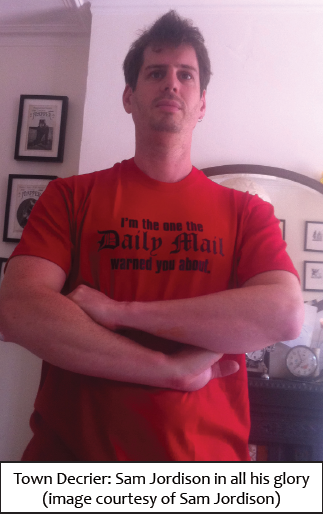The man behind Crap Towns Returns chats to Adam Steiner
Adam Steiner: What was the initial inspiration behind Crap Towns?
Sam Jordison: Growing up near Morecambe. It was a beautiful place, but its best days seemed too far behind it. The council had made all kinds of terrible decisions about its future (including spending millions trying to build a Mr Blobby theme park), its best buildings were in ruin (and people were using them as toilets) and the town had become a strange combination of dangerous and boring to visit… It was enraging, but also quite funny. Back then when you visited Morecambe you didn’t know whether to laugh or cry – and that was quite potent. I was also convinced it was the inspiration for Everyday Is Like Sunday and wrote a little article riffing on that idea, put it on the web and luckily, it hit a nerve… It turns out thousands of other people have similar feelings about their home towns. (I’m glad to say that Morecambe has since got much better. It still has problems, but a good part of it is lovely again. Truly beautiful, in fact.)
 AS: Why the gap between the two books?
AS: Why the gap between the two books?
SJ: Oh the usual: legal fights, rip-offs, a plague of conmen and work-shirkers. Also ten years is a nice gap. (So long as you discount Crap Towns II, which arrived in 2004.)
AS: What makes a town crap?
SJ: Crap is in the eye of the beholder! I think that every time has its own brand of crap, which is possibly what makes the idea work. Everyone too, has those Bruce Springsteen feelings of love for a place combined with a burning desire to get the rock away and find something else… Plus, you know, bad planning decisions, anti-social behaviour, snobbery, consumption, supermarkets…
AS: Is the UK getting crappier?
SJ: Not really a question you have to ask under a Tory government. For 99% of the population, life is getting worse.
AS: What do you hope to achieve with the book?
SJ: Wealth, fame, adulation… Failing that, I guess I want to provoke thought about the way we look after our towns, about the way our councils do or don’t look after us, about planning decisions, about local pride, about inequality and good governance. I want to provide a platform for people in places like Bradford to say that this really isn’t good enough and we have to do something about it. I want to give voice to the people who are rightly pointing out the problems in their towns and an opportunity for them to be heard. I also want to give lots of people a good laugh and something fun to read on the toilet.
AS: What are some of your favourite Crap Towns/places – and why?
SJ: Well, I love Morecambe. A good part of the inspiration from the book came from my affection for the place, if that doesn’t sound like too much of a contradiction. I think people get frustrated with their towns partly because they are so important to them. Elsewhere, I’ve always liked Hull, in spite of its problems, and especially now that it’s started to turn itself around. And there’s something captivating about the seaside places. Blackpool, Great Yarmouth… On a rainy day, they are both utterly miserable and incredibly beautiful. And under all the horrible slot machine arcades and neon signs, they often have beautiful buildings…
AS: After a popular vote, architects/town planners were blamed for reducing many towns to a concrete jungle or cultural and economic wasteland – what are your views on this?
SJ: It’s not entirely fair. The people who pay for the buildings, and who don’t look after them properly are as much to blame. A lot of the worst architecture comes about thanks to compromises with councils, planners and corporations, not because the men in black-framed glasses are inherently evil. We also have architects to thank for most of our towns’ best features. And it wasn’t architects who, for instance, drove a great big road through the middle of Birmingham and tore the heart out of the city. That said, they did design New Street Station… And they did spend a lot of the second half of the 20th century refusing to listen to people when they told them what they didn’t and did like…
AS: Are you surprised by the mixed responses of agreement and refusal – especially when people defend their crap town?
SJ: Not really! The defences generally come from politicians who are, I suppose, duty bound to defend the towns, and also generally, shameless liars, so little they say surprises me. But sometimes people do point out genuinely good things about their towns, which I try to take into account…
AS: How do you think towns can change to become less crap?
SJ: The things people often ask for are more shops owned by local people that have a stake in the community, better preservation of treasured old buildings, more greenery and less litter… But there isn’t any one answer. Morecambe did it by starting to treasure its past. Hull by looking to the future and going for ambitious new developments and new cultural programmes. Todmorden has been given a new lease of life by people putting flowers and veg patches all over the town. I guess the starting point is listening to the people who live in the town both about what they want and what they can offer.
AS: What is the future for Crap Towns, both the book and the actual places themselves?
SJ: Well, it’s going to be interesting. We need a lot of new housing in the UK. There’s talk of new towns on the way… I can’t wait to see how they turn out. But the fascinating thing is that I just don’t know. 10 years ago, I wouldn’t have predicted the coalition and the rise and rise of the ultra-rich at the expense of everyone else. I certainly wouldn’t have expected to see so many food banks in UK cities. On the other hand, I wouldn’t have thought that people in Hull could do so much so quickly to turn things around. There are always pleasant and unpleasant surprised, and that’s what makes the subject so compelling… I hope to do another book in 10 years, but I don’t know what’s going to go in it!
